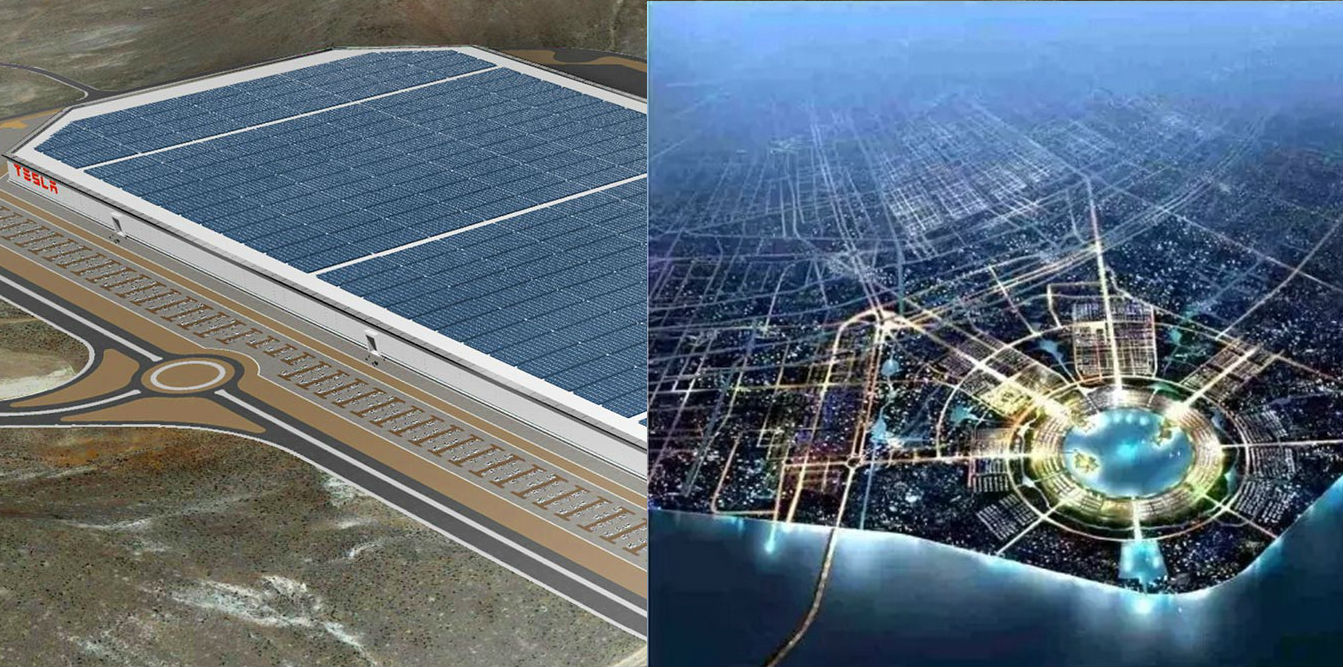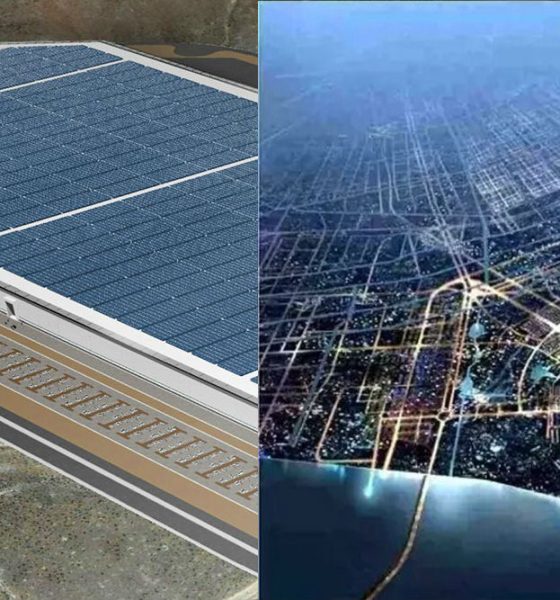

Investor's Corner
Tesla’s Gigafactory 3 is starting to attract the interest of China’s workforce
Tesla’s upcoming Gigafactory 3 in Shanghai appears to be attracting a lot of interest among China’s workers, with a recent recruitment day for the facility attracting a larger-than-expected number of applicants. Videos taken of the job fair show long lines of interested candidates waiting their turn to submit their applications for the factory.
Local media reports noted that Tesla’s job fair, which was held at the Lingang Industrial Zone, was initially set to end at 3:30 p.m. local time. To accommodate the number of candidates applying for a post in Gigafactory 3, though, Tesla ended up extending its hiring hours. Several applicants interviewed by local media also pointed out that they took the effort of traveling to Shanghai to apply for a job in the upcoming Tesla facility.
Update (Video) about:
Tesla Shanghai Gigafactory held a job fair in the Lingang Industrial Zone. As you can see from the video provided by Chinese media https://t.co/CmnfB7Cj1u ,huge amount candidates are interested to join $TSLA for GF3 development.#Tesla #China #TeslaChina pic.twitter.com/mSZxyf5S5w
— vincent (@vincent13031925) November 30, 2018
The warm reception to Tesla’s recent job fair in Shanghai bodes well for Gigafactory 3’s development. Tesla, after all, announced in its third-quarter vehicle delivery and production report that it is expediting the construction of the factory, which is expected to be capable of producing both battery packs and electric vehicles. In its report, Tesla noted that it expects Gigafactory 3’s buildout to be quick and efficient, particularly as the company would be applying the lessons it learned during the Model 3 production ramp on the facility.
Tesla’s business in China has been challenged this year due to additional import tariffs placed by the government against vehicles imported abroad. Despite this, though, Tesla’s brand has remained strong in the country, partly due to its reputation as the manufacturer of some of the most desirable electric vehicles in the market. Amidst China’s aggressive plan of adopting electric cars in its key cities, Tesla’s place as one of the first movers in the EV industry appears to be valued by the country as well.
The development and progress of Gigafactory 3 has been remarkable so far, thanks in part to the Chinese government’s support for the project. Over the past months, state media has run multiple segments about how the state fully supports the construction of the factory. This support became quite evident when China made the rare decision to allow Tesla to become the sole owner of Gigafactory 3. The electric car maker’s bid for the 864,885-square meter plot of land in Shanghai’s Lingang area went unchallenged by any rival bidders as well. Apart from these, low-interest loans from local banks were also secured quickly, with local news site Beijing Business Daily noting that around 30% of the facility’s funds have been ready since October.
China has agreed to reduce and remove tariffs on cars coming into China from the U.S. Currently the tariff is 40%.
— Donald J. Trump (@realDonaldTrump) December 3, 2018
Apart from the apparent high interest among job applicants for Gigafactory 3, Tesla’s business would likely see a notable boost this quarter, thanks to changing headwinds in the ongoing US-China trade war. In a recent tweet, US President Donald Trump suggested that China has agreed to “reduce and remove” import tariffs on vehicles coming in from the United States. Considering that Tesla’s electric cars are weighed down by a 40% tariff, the reduction or removal of the duties would likely result in better Q4 figures.
Tesla has ambitious plans for Gigafactory 3, with the company aiming to produce up to 500,000 electric vehicles every year once construction is complete. Two of the company’s high-volume vehicles, the Model 3 sedan and the Model Y SUV, are expected to be produced in the upcoming facility, which would specifically cater to the Chinese market.

Investor's Corner
Tesla stock closes at all-time high on heels of Robotaxi progress

Tesla stock (NASDAQ: TSLA) closed at an all-time high on Tuesday, jumping over 3 percent during the day and finishing at $489.88.
The price beats the previous record close, which was $479.86.
Shares have had a crazy year, dipping more than 40 percent from the start of the year. The stock then started to recover once again around late April, when its price started to climb back up from the low $200 level.
This week, Tesla started to climb toward its highest levels ever, as it was revealed on Sunday that the company was testing driverless Robotaxis in Austin. The spike in value pushed the company’s valuation to $1.63 trillion.
Tesla Robotaxi goes driverless as Musk confirms Safety Monitor removal testing
It is the seventh-most valuable company on the market currently, trailing Nvidia, Apple, Alphabet (Google), Microsoft, Amazon, and Meta.
Shares closed up $14.57 today, up over 3 percent.
The stock has gone through a lot this year, as previously mentioned. Shares tumbled in Q1 due to CEO Elon Musk’s involvement with the Department of Government Efficiency (DOGE), which pulled his attention away from his companies and left a major overhang on their valuations.
However, things started to rebound halfway through the year, and as the government started to phase out the $7,500 tax credit, demand spiked as consumers tried to take advantage of it.
Q3 deliveries were the highest in company history, and Tesla responded to the loss of the tax credit with the launch of the Model 3 and Model Y Standard.
Additionally, analysts have announced high expectations this week for the company on Wall Street as Robotaxi continues to be the focus. With autonomy within Tesla’s sights, things are moving in the direction of Robotaxi being a major catalyst for growth on the Street in the coming year.
Elon Musk
Tesla needs to come through on this one Robotaxi metric, analyst says
“We think the key focus from here will be how fast Tesla can scale driverless operations (including if Tesla’s approach to software/hardware allows it to scale significantly faster than competitors, as the company has argued), and on profitability.”

Tesla needs to come through on this one Robotaxi metric, Mark Delaney of Goldman Sachs says.
Tesla is in the process of rolling out its Robotaxi platform to areas outside of Austin and the California Bay Area. It has plans to launch in five additional cities, including Houston, Dallas, Miami, Las Vegas, and Phoenix.
However, the company’s expansion is not what the focus needs to be, according to Delaney. It’s the speed of deployment.
The analyst said:
“We think the key focus from here will be how fast Tesla can scale driverless operations (including if Tesla’s approach to software/hardware allows it to scale significantly faster than competitors, as the company has argued), and on profitability.”
Profitability will come as the Robotaxi fleet expands. Making that money will be dependent on when Tesla can initiate rides in more areas, giving more customers access to the program.
There are some additional things that the company needs to make happen ahead of the major Robotaxi expansion, one of those things is launching driverless rides in Austin, the first city in which it launched the program.
This week, Tesla started testing driverless Robotaxi rides in Austin, as two different Model Y units were spotted with no occupants, a huge step in the company’s plans for the ride-sharing platform.
Tesla Robotaxi goes driverless as Musk confirms Safety Monitor removal testing
CEO Elon Musk has been hoping to remove Safety Monitors from Robotaxis in Austin for several months, first mentioning the plan to have them out by the end of 2025 in September. He confirmed on Sunday that Tesla had officially removed vehicle occupants and started testing truly unsupervised rides.
Although Safety Monitors in Austin have been sitting in the passenger’s seat, they have still had the ability to override things in case of an emergency. After all, the ultimate goal was safety and avoiding any accidents or injuries.
Goldman Sachs reiterated its ‘Neutral’ rating and its $400 price target. Delaney said, “Tesla is making progress with its autonomous technology,” and recent developments make it evident that this is true.
Investor's Corner
Tesla gets bold Robotaxi prediction from Wall Street firm
Last week, Andrew Percoco took over Tesla analysis for Morgan Stanley from Adam Jonas, who covered the stock for years. Percoco seems to be less optimistic and bullish on Tesla shares, while still being fair and balanced in his analysis.

Tesla (NASDAQ: TSLA) received a bold Robotaxi prediction from Morgan Stanley, which anticipates a dramatic increase in the size of the company’s autonomous ride-hailing suite in the coming years.
Last week, Andrew Percoco took over Tesla analysis for Morgan Stanley from Adam Jonas, who covered the stock for years. Percoco seems to be less optimistic and bullish on Tesla shares, while still being fair and balanced in his analysis.
Percoco dug into the Robotaxi fleet and its expansion in the coming years in his latest note, released on Tuesday. The firm expects Tesla to increase the Robotaxi fleet size to 1,000 vehicles in 2026. However, that’s small-scale compared to what they expect from Tesla in a decade.
Tesla expands Robotaxi app access once again, this time on a global scale
By 2035, Morgan Stanley believes there will be one million Robotaxis on the road across multiple cities, a major jump and a considerable fleet size. We assume this means the fleet of vehicles Tesla will operate internally, and not including passenger-owned vehicles that could be added through software updates.
He also listed three specific catalysts that investors should pay attention to, as these will represent the company being on track to achieve its Robotaxi dreams:
- Opening Robotaxi to the public without a Safety Monitor. Timing is unclear, but it appears that Tesla is getting closer by the day.
- Improvement in safety metrics without the Safety Monitor. Tesla’s ability to improve its safety metrics as it scales miles driven without the Safety Monitor is imperative as it looks to scale in new states and cities in 2026.
- Cybercab start of production, targeted for April 2026. Tesla’s Cybercab is a purpose-built vehicle (no steering wheel or pedals, only two seats) that is expected to be produced through its state-of-the-art unboxed manufacturing process, offering further cost reductions and thus accelerating adoption over time.
Robotaxi stands to be one of Tesla’s most significant revenue contributors, especially as the company plans to continue expanding its ride-hailing service across the world in the coming years.
Its current deployment strategy is controlled and conservative to avoid any drastic and potentially program-ruining incidents.
So far, the program, which is active in Austin and the California Bay Area, has been widely successful.








